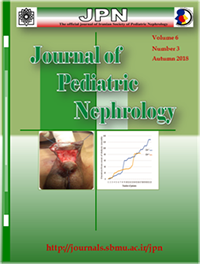Intra-Dialysis Hypotension in Patients Undergoing Hemodialysis
Journal of Pediatric Nephrology,
Vol. 6 No. 3 (2018),
19 Bahman 2019
,
Page 1-9
https://doi.org/10.22037/jpn.v6i3.23054
Abstract
Introduction: Intra-dialysis hypotension occurs in 20- 55% of hemodialysis sessions. We aimed to define the prevalence and impact of pre-dialysis blood pressure, inter-dialysis weight gain, vasodilator agents, and characteristics of dialysis, serum calcium, and adjusted calcium, sodium, and albumin levels on intra-dialysis hypotension.
Materials and Methods: In an observational prospective study, 44 hemodialysis cases aged 4.8-25 years were evaluated in 552 dialysis sessions. A decrease in the mean arterial blood pressure ≥ 10 mm Hg was defined as intra-dialysis hypotension. The characteristics of the patients were compared between cases and those without intra-dialysis hypotension.
Results: Intra-dialysis hypotension was noted in 61.4% of the cases and 24.6% of the dialysis sessions. The duration of hemodialysis, weight gain between dialysis sessions, using vasodilator medications, serum sodium and adjusted calcium levels were compared between IDH + and IDH – cases. No significant differences were found in these variables between the 2 groups (P> 0.05 for all). Intra-dialysis hypotension was significantly more prevalent in cases with normal versus high systolic and diastolic blood pressure (P=0.014 and P=0.005 respectively). Intra-dialysis hypotension was significantly more frequent in girls, anuric patients, and patients with a history of transplantation (p=0.022, 0.011 and 0.008 respectively). A Significantly lower serum albumin concentration was found in cases with intra –dialysis hypotension (P=0.021).
Conclusions: Intra-dialysis hypotension is a common complication of hemodialysis and is more prevalent in girls, normotensive patients, subjects with lower serum albumin concentrations, cases with a history of transplantation, and anuric patients.
Keywords: Hemodialysis; Blood Pressure; Hypotension; Serum Albumin; Serum Calcium.
- Hemodialysis
- IDH
- BP
- serum albumin levels
- serum calcium levels
How to Cite
References
Meredith DJ, Pugh CW, Sutherland S, Tarassenko L. The relationship between symptoms and blood pressure during maintenance hemodialysis. Hemodial Int . 2015; 19(4):543-52.
Flythe JE, Xue H, Lynch KE, Curhan GC, Brunelli SM. Association of Mortality Risk with Various Definitions of Intradialytic Hypotension. J Am Soc Nephrol. 2015; 26(3): 724–734.
Chesterton LJ, Selby NM, Burton JO, McIntyre CW. Cool dialysate reduces asymptomatic intradialytic hypotension and increases baroreflex variability.Hemodial Int.2009; 13(2):189-96.
Knoll GA, Grabowski JA, Dervin GF, O’Rourke K. A randomized, controlled trial of albumin versus saline for the treatment of intradialytic hypotension. J Am Soc Nephrol.2004; 15(2):487–92.
Kuipers J, Oosterhuis JK, Krijnen WP, et al. Prevalence of intradialytic hypotension, clinical symptoms and nursing interventions--a three-months, prospective study of 3818 hemodialysis sessions. BMC Nephrol.2016; 17:21.
Kosch M, Levers A, Fobker M, et al .Dialysis filter type determines the acute effect of hemodialysis on endothelial function and oxidative stress. Nephrol Dial Transplant .2003; 18(7):1370-5.
Brewer ED. Evaluation of hypertension in childhood diseases. In: Avner ED, Harmon WE, Niaudet P, Yoshikawa N, eds. Text book of pediatric nephrology. 6th edition. Berlin: Springer, 1459-1485.
U.S Department of health and human services. Seventh report of the joint the national committee on prevention, detection, evaluation, and treatment of high blood pressure. Hypertension .2003;42: 1206-1252.
Fischbach M, Zaloszyc A, Laetitia H, Menouer S. Why does three times per week hemodialysis provide inadequate dialysis for children? Hemodialysis International.2014; 18:S39–S42.
Nerbass FB, Morais JG, Santos RG, Krüger TS, Koene TT, Filho HA. Factors related to inter dialytic weight gain in hemodialysis patients. J Bras Nefrol .2011;33(3):300-5.
McIntyre CW. Recurrent Circulatory Stress: The Dark Side of Dialysis. Seminars in Dialysis .2010;23(5):449–451.
Agarwal R. How can we prevent intradialytic hypotension? Curr Opin Nephrol Hypertens.2012; 21(6):593 –9.
Flythe JE, Kimmel SE, Brunelli SM. Rapid fluid removal during dialysis is associated with cardiovascular morbidity and mortality. Kidney Int.2011; 79(2):250– 7.
Jefferies HJ, Burton JO, McIntyre CW. Individualized dialysate temperature improves intradialytic hemodynamics and abrogates hemodialysis induced myocardial stunning, without compromising tolerability. Blood Purif.2011; 32(1):63 – 8.
Hothi DK, Harvey E, Goia C, Geary D. Evaluating methods for improving ultrafiltration in pediatric hemodialysis. Pediatr Nephrol.2008; 23:631 – 638.
Donauer J, Kolblin D, Bek M, Krause A, Bohler J .Ultrafiltration profiling and measurement of relative blood volume as strategies to reduce hemodialysis related side effects. Am J Kidney Dis.2000; 36:115– 123.
Gabutti L, Bianchi G, Soldini D, Marone C, Burnier M .Hemodynamic consequences of changing bicarbonate and calcium concentrations in hemodialysis fluids. Nephrol Dial Transplant .2009;24:973 – 981.
Genovesi S, Dossi C, Viganò MR, et al. Electrolyte concentration during hemodialysis and QT interval prolongation in uremic patients. Europace.2008; 10:771 –777.
Shoji T, Tsubakihara Y, Fujii M, Imai E .Hemodialysis-associated hypotension as an independent risk factor for two-year mortality in hemodialysis patients. Kidney Int.2004; 66(3):1212-20.
Mitra S, Chamney P, Greenwood R, Farrington K. Linear decay of relative blood volume during ultrafiltration predicts hemodynamic instability. Am J Kidney Dis.2002; 40:556 –565.
- Abstract Viewed: 376 times
- PDF Downloaded: 185 times

